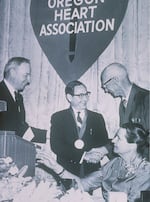On a spring day in 1958, Lowell Edwards paid a visit to Dr. Albert Starr, a young cardiac surgeon recruited to run the new open heart surgery program at the University of Oregon Medical School — now Oregon Health & Science University — in Portland.
Edwards was a 60-year-old retired hydraulic engineer and inventor. He’d become quite wealthy from his more than 60 patents — mostly from designing industrial pumps.
Edwards recognized that the human heart is also a pump. So he proposed that he and Starr work together to develop an artificial heart valve. If successful, it could replace a person’s failing heart valve and save many lives.

Co-inventors of the world’s first artificial mitral heart valve, Albert Starr (L) and Lowell Edwards (R) pictured in his Sandy River workshop.
Courtesy of the Oregon Health & Science University Historical Collections & Archives and Teresa Edwards Allen
It was a bold suggestion from an unlikely source.
“Starr could have thought this guy is crazy but he didn’t,” said OHSU emeritus professor of surgery, Dr. Richard Mullins. “He paid attention and the two had a conversation.”
“I told him I thought it was a good idea,” remembered Starr, “but it was too early and that we should start by working on the project one heart valve at a time.”
Their somewhat chance encounter was the genesis of an extraordinary collaboration between a surgeon and an engineer — medicine and industry — an improbable alliance at the time.
“My grandfather knew the mechanical part of it whereas Dr. Starr knew all about the heart and its function,” said Lowell’s granddaughter Teresa Edwards Allen. “They needed each other. They had to work together.”
Few could have predicted the outcome. Starr saw an opportunity and seized it. So for the next two years, Starr and Edwards maintained constant communication.
Edwards continued designing and making valve prototypes in his home workshop. Starr implanted the prototypes during experimental animal surgeries. Along the way, he developed a precisely detailed procedure to train other surgeons in the method.
Starr and Edwards ongoing design modifications and improvements would ultimately produce a rather odd-looking contraption: a free-floating silicone rubber ball enclosed in an acrylic cage.

First successful Starr-Edwards artificial mitral heart valve.
Courtesy of the Oregon Health & Science University Historical Collections & Archives
It looked nothing like a natural heart valve, but for Starr and Edwards, function mattered more than form. The valve had to work regardless of its looks. Its job — as one of four heart valves — was to keep blood circulating one way only.
In September 1960, Starr and his team successfully implanted the Starr-Edwards caged ball prototype into a human being. The patient, who was near death, would survive and enjoy an active life for another 10 years.
There would be more survivors — many more.

Albert Starr and Lowell Edwards in 1963.
Courtesy of the Oregon Health & Science University Special Collections & Archives
Over the years, the device would undergo further modifications improving and prolonging the lives of hundreds of thousands of people who suffered from diseased or damaged heart valves that could not be repaired.
Starr would later write, “In retrospect we had produced a ‘black swan’ — an occurrence of low predictability and large impact.”
The valve’s unprecedented success ushered in a new era of valve design and valve replacement surgery. Bioprosthetic heart valves made from animal tissue would provide another treatment option that lessened the danger of clot formation and the need for blood-thinning drugs.
Back in 1958, Edwards had an idea that the world needed a mechanical heart. Starr saw the journey ahead as one step — one valve — at a time.
“Today in 2023, mechanical hearts are being used, but they need to get better,” said Mullins. “That’s the new challenge and Lowell Edwards saw it right from the beginning. That was going to be the answer.”
Related Content

